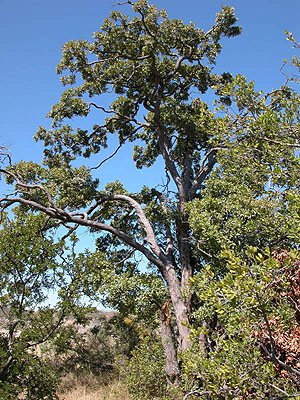Gambel Oak, Emory’s Oak, Vasey Shin Oak
Quercus emoryi J. Torrey, Quercus gambelii T. Nuttall,
Quercus pungens Liebm. var pungens
Fagaceae (Beech Family)
The Trans-Pecos is home to more than 20 oak species; at least 17 of which grow in Big Bend National Park. Oaks were a necessary, if not always preferred, native food source and also provided excellent wood for implements and fuel. The tannins in the acorns, bark, and leaves provided a source of medicine.
The three oaks featured here are widespread in the mountains of the Trans-Pecos and were chosen for discussion because they produce acorns that are low in tannin. The acorns of Gambel oak and Emory oak were preferred by the Mescalero Apache. All three species are small to medium trees; Emory and Vasey oak can be seen on mountain slopes at medium elevations between 4,000-6,000 ft and Gambel oak at higher elevations (Clelland 2001; Powell 1998).
Archeology. Although oak wood charcoal is commonly recorded from archeological sites, other plant parts, especially acorns, are rare. Acorns consist of a hard pericarp fused to a seedcoat that surrounds two softer cotyledons that store food in the form of carbohydrates. Gaining access to the carbohydrates required removing the pericarp by hand. The soft cotyledons are seldom preserved in archeological deposits unless they are protected by an overhang, cave, or rockshelter.
Recently, the Escondido Rockshelter (41PS900) in Presidio County excavated by the Center for Big Bend Studies at Sul Ross State University yielded acorn fragments (Dering 2006). This find provides more direct evidence for a deep history of use in the Trans-Pecos.
Food. Basehart (1960) reports that acorns were not a preferred food of the Mescalero Apache, who claimed that they did not store well and that the taste was not particularly good. The bottom line is, however, that processing acorns one pericarp or shell at a time is tedious and relatively unrewarding work. They did, however, use them, and preferred the oaks growing in their southern territory. They boiled and pounded the acorn meat (cotyledon) into flour, and mixed this with agave. Basehart notes that some Mescalero liked to eat acorns raw.
The Western Apache harvested the acorns of Gambel and Emory oak, both of which grow widely in the Trans-Pecos. Some groups used large poles to dislodge the acorns. Sweet varieties, which would include the Gambel and shin oaks, could be eaten without further processing, but taste can vary from tree to tree. Stone mortars and metates were used to grind the acorns after shelling. Some groups, notably the Cibecue and White Mountain, claimed that boiling the sweet acorns ruined the taste. The White Mountain Apache parched acorns before processing them (Buskirk 1986). Castetter and Opler (1936) report that the Chiricahua mixed, roasted, and pounded acorns with dried meat, storing it for future consumption.
Writing about use of the acorn in Baja California, Weiss has reported that acorn meal is a very healthy source of fiber, fat, protein, and carbohydrates. Its carbohydrates digest slowly, an important difference from our over-processed grocery store foods. She reports that acorn meal from commonly utilized California species contains between 5.5-18.0 percent fats, about 60 percent carbohydrates, and 4-6 percent protein, a very good nutrient content for any plant food (reported in Weiss 1994:162, adapted from Mayer 1976).
Medicine. Medicinal applications took advantage of the abundance of tannins in the bark and leaves of oak trees. A decoction of the root bark of Gambel oak was used by the Ramah Navajo as a cathartic, a ceremonial emetic, and for postpartum pain, obviously at different dosages (Vestal 1952).
Implements, construction, and dyes. The Ramah Navajo used Gambel oak wood to construct baby cradle boards and bullroarers (Vestal 1952). Many southwestern groups used oak stems as handles for implements, including the Ramah Navajo, Havasupai, Kawaiisu, Mescalero Apache, and many Western Apache (Basehart 1960; Buskirk 1986; Vestal 1952; Weber and Seaman 1985; Zigmond 1981). The Mescalero used oak wood to fashion agave digging sticks, tweezers for prickly pear collection, stirrups, and platters for holding agave cakes (Basehart 1960). The Western Apache preferred oak digging sticks. The green sticks were passed through a fire to harden the tips. The White Mountain Apache used tannin from the Gamble oak bark to process skins (Buskirk 1986).
References
Basehart, Harry
1960 Mescalero Apache Subsistence Patterns and Socio-Political Organization. The University of New Mexico Mescalero-Chiricahua Land Claims Project Contract Research #290-154. University of New Mexico. Albuquerque.
Buskirk, Winfred
1986 The Western Apache: Living with the Land Before 1950. University of Oklahoma Press, Norman.
Dering, J. Phillip
2006 Plant Remains from 41PS900, Escondido Rockshelter. Report submitted to the Center for Big Bend Studies, Sul Ross State University.
Vestal, Paul
1952 Ethnobotany of the Ramah Navaho. Papers of the Peabody Museum of American Archaeology and Ethnology 40 (4). Harvard University. Boston.
Weber, Steven A. and P. David Seaman
1985 Havasupai Habitat: A. F. Whiting's Ethnography of a Traditional Indian Culture. University of Arizona Press. Tucson.
Weiss, Audrey E.
1994 The Impact of Nutritonal Change on the Emergence of Diabetes in Two Tipai Cochimí Communities in Baja California. Unpublished Dissertation. University of California, Irvine. UMI. Ann Arbor, Michigan.
Zigmond, Maurice L.
1981 Kawaiisu Ethnobotany. University of Utah Press. Salt Lake City.

